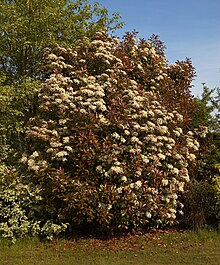
Back فوتينيا Arabic فوتينيا ARZ Fotiniya Azerbaijani Fotínia Catalan Photinia CEB Blýskalka Czech Glansmispel Danish Glanzmispeln German Photinia Spanish سهرنگ (سرده) Persian
| Photinia Temporal range:
| |
|---|---|

| |
| Photinia Glansmispel × fraseri | |
| Scientific classification | |
| Kingdom: | Plantae |
| Clade: | Tracheophytes |
| Clade: | Angiosperms |
| Clade: | Eudicots |
| Clade: | Rosids |
| Order: | Rosales |
| Family: | Rosaceae |
| Subfamily: | Amygdaloideae |
| Tribe: | Maleae |
| Subtribe: | Malinae |
| Genus: | Photinia Lindl.[2] |
| Species | |
|
See text | |
| Synonyms[2] | |
| |
Photinia (/foʊˈtɪniə, fə-/[3][4][5]) is a genus of about 30 species of small trees and large shrubs, but the taxonomy has recently varied greatly,[when?] with the genera Heteromeles, Stranvaesia and Aronia sometimes included in Photinia.
They are a part of the rose family (Rosaceae) and related to the apple. The botanical genus name derives from the Greek word photeinos for shiny and refers to the often glossy leaves. Most species are evergreen, but deciduous species also occur. The small apple-shaped fruit has a size of 4 to 12 mm and forms in large quantities. They ripen in the fall and often remain hanging on the bush until well into the winter. The fruits are used as food by birds, which excrete the seeds with their droppings and thereby distribute the plant.
The natural range of these species is restricted to warm temperate Asia, from the Himalaya east to Japan and south to India and Thailand. They have, however, been widely cultivated throughout the world as ornamentals for their white flowers and red fruits.
The scientific name Photinia is also widely used as the common name. Another name sometimes used is "Christmas berry", but this name is a source of confusion, since it is commonly applied to plants in several genera including Heteromeles, Lycium, Schinus, and Ruscus. The name "photinia" also continues to be used for several species of small trees in the mountains of Mexico and Central America which had formerly been included in the genus Photinia.[6]
- ^ "Rosales". www.mobot.org. Retrieved 2023-06-16.
- ^ a b Cite error: The named reference
POWOwas invoked but never defined (see the help page). - ^ Sunset Western Garden Book, 1995:606–607
- ^ "Photinia". Lexico UK English Dictionary. Oxford University Press.[dead link]
- ^ "Photinia". Dictionary.com Unabridged (Online). n.d. Retrieved 2016-01-22.
- ^ Phipps, J.B. (1992). "Heteromeles and Photinia (Rosaceae subfam. Maloideae) of Mexico and Central America". Canadian Journal of Botany. 70 (11): 2138–62. doi:10.1139/b92-266.
© MMXXIII Rich X Search. We shall prevail. All rights reserved. Rich X Search